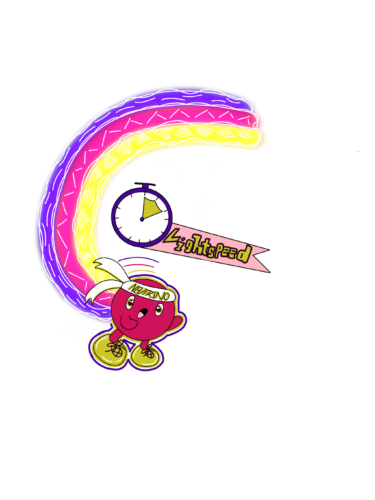Art Courtesy of Yuanyu Chen.
Physics-bending findings. Irreproducible results. In 2011, news of neutrinos, neutral particles with infinitesimal mass, traveling faster than the speed of light topped science headlines, prompting widespread debate about the truth of these findings. The debate stemmed from the fact that Einstein’s theory of special relativity says nothing can travel faster than light. But the Oscillation Project with Emulsion-tRacking Apparatus (OPERA) experiment at the underground Gran Sasso Lab (LNGS), had measured the velocity of neutrinos to be 0.0024 percent faster than lightspeed, contradicting Einstein. If OPERA’s results were true, a core theory of physics would be shaken.
The premise of this measurement was simple: send a beam of neutrinos 730 kilometers from the European Organization for Nuclear Research (CERN) to the OPERA detector at LNGS and measure their time of flight. Yet, OPERA’s primary goal was not to measure neutrinos’ speed. The researchers conducted the additional measurement because OPERA was well suited to accurately determine neutrino velocity. The OPERA experiment had primarily been designed to test the phenomenon of neutrino oscillations, which occur when neutrinos oscillate between three known “flavors”: electron, muon, and tau. Located at the LNGS, the OPERA system aimed to be the first to detect the appearance of tau-neutrinos from the oscillation of muon-neutrinos during the 2.4-millisecond trip from CERN to Gran Sasso.
The researchers exhaustively checked every part of the experiment that could have caused the unexpectedly fast neutrino speed. They debated whether the research should be made public. Some didn’t think the checks and tests on the equipment and experimental methods had been exhaustive enough. “I was skeptical—almost sure it was wrong,” said Laura Patrizii, a member of the OPERA Collaboration. Putting it to a vote, the researchers pushing for sharing their potentially revolutionary findings won out.
However, since many working on the project maintained that something had gone wrong, the Collaboration didn’t submit for publication in a scientific journal and instead posted to arXiv.org, a non-peer-reviewed open-access archive. Meanwhile, the OPERA researchers continued to investigate still-unknown systematic effects that could explain the anomalous result.
“Exceptional results require exceptional checks,” Patrizii said, paraphrasing Carl Sagan, astronomer and well-known science communicator. OPERA’s error-searching efforts proceeded in tandem with labs across the world that tried to replicate the results—to no avail. Other research groups noted that if the neutrinos were truly traveling at light-surpassing speed, they should have also been releasing energy. But no trace of this energy was seen in the experiment, increasing doubt about the measurements.
In 2012, OPERA finally disproved its own findings. The Collaboration found that there were two sources of error that had caused the observed relativity-defying speed. First, a connector measuring the time delay from a GPS receiver to the OPERA Master Clock was faulty, and second, the frequency of the Master Clock was out of specification. The researchers had calibrated the connector when it was securely plugged in, but during the experiment it had been partially disconnected, resulting in a distortion and delay of the signal. After the time delay was calculated and accounted for, the neutrino interactions with OPERA lagged by sixty nanoseconds. The neutrinos hadn’t actually traveled faster than the speed of light—the timing itself was incorrect. The search for an explanation was finally over.
In 2014 and 2015, OPERA papers shared the neutrino oscillation data. Like all other findings from CERN, they underwent multiple reviews and screenings before being released to the public. Today, the common worldwide policy for peer review even bans graduate students conducting research at CERN from including figures made for their own research in any university papers if the figures involve CERN projects that have not been finalized. Any results they do share from a non-finalized project leave CERN marked as “preliminary.” This rigorous peer-review process reflects how the scientific process preserves scientists’ credibility, just as researchers around the world constructively critiqued the neutrino speed findings.
“The ‘case’ of superluminal neutrinos is frequently referenced as an example of how science operates, highlighting the effectiveness of the scientific method and its provando e riprovando (trying and trying again) approach,” Patrizii said. “Science is not a belief system; it operates without dogma.” The researchers’ desire to ensure their findings’ validity, even if it would negate what would otherwise be a groundbreaking finding, shows the scientific community’s dedication to better understanding the universe. This case of the too-fast neutrinos, rather than being a scientific failure, was actually an example of the success of the scientific process.

